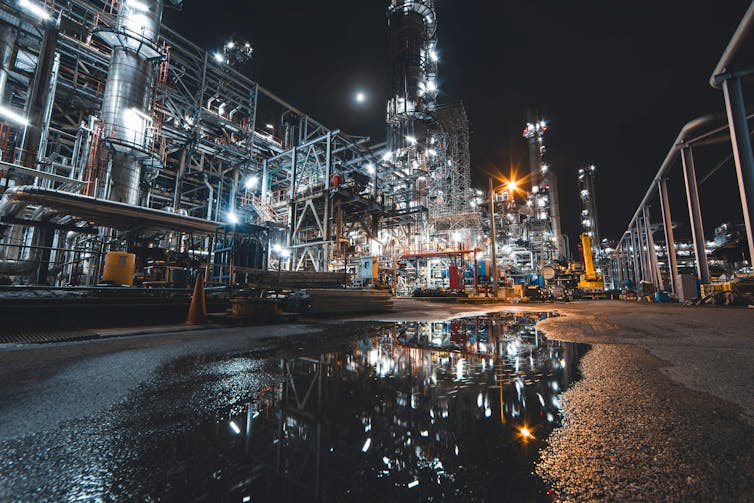When did the climate crisis begin?

William Bell Scott
How old is the climate crisis?
I was born in 1994, when the concentration of CO₂ in the atmosphere was measured at 360 parts per million; today it is close to 420. Furnaces, engines and former forests emitted 23 billion tonnes of this planet-warming gas in 1994; today they spew more than 37 billion tonnes. With some exceptions (economic downturns, the pandemic), humanity has released more CO₂ into the atmosphere each year than the one before it for at least two centuries.
Earth is not only hotter as a result of all this additional greenhouse gas, it is also getting hotter at a faster and faster rate. Where did it all begin? Figuring that out can tell us who or what is responsible – and what a possible solution looks like.
One way to answer the question at the start of this newsletter is to identify when people first noticed that the planet was warming. This happened during the mid-20th century. Tragically, it did so among scientists whose funders preferred that the world remain ignorant.
The 1970s: a critical decade
One company intimately involved with the emerging science of climate change was Exxon (now ExxonMobil). Scientists working for this oil and gas giant were modelling Earth’s climate in the 1970s to understand how the increasing carbon content of the atmosphere would affect temperatures – and Exxon’s future as a business.
According to a study published in 2017 that involved scouring the company’s internal documents, Exxon scientists acknowledged back then that climate change was real and overwhelmingly caused by burning the same fossil fuels Exxon sold.
“Yet over 80% of Exxon’s editorial-style paid advertisements over the same period specifically focused on uncertainty and doubt, the study found,” says Katharine Hayhoe, professor and director of the Climate Science Center at Texas Tech University.
Exxon knew better – a lot better. An investigation published last year showed that forecasts of the future climate made by Exxon scientists in the 1970s were remarkably accurate. The company knew where the world was headed by continuing to burn coal, oil and gas and instead endeavoured to cover it up.

Noomcpk/Shutterstock
The fossil fuel industry not only delayed a coordinated response to climate change, allowing it to grow into an existential threat to life on Earth. It also warped our understanding of who is responsible says Marcelle McManus, a professor of energy and environmental engineering at the University of Bath.
Take a concept like the carbon footprint. This calculates how much CO₂ is emitted in the process of making, using and disposing of something – cars, electrons, buildings. Such an analytical tool is useful, McManus says, but its most heavily promoted application has been in measuring the impact of individuals.
How differently history might have unfolded if the fossil fuel industry hadn’t obscured what was happening to the climate for several decades. John Grant, a sustainability expert at Sheffield Hallam University, argues that the crisis could have been solved by now – and the enormous potential of renewable energy realised much sooner.
Instead, a selection of companies, chiefly concerned with maximising profit, were allowed to decide the fate of all Earth’s inhabitants. Perverse as that may seem, our economic system enables this by leaving the means of producing the things people need (like energy) in private hands.
From Amsterdam to the world
One of the first entities we might recognise as a private business (with shares that could be bought and sold on the Amsterdam Stock Exchange) was the Dutch East India Company. Granted a monopoly over trading activities in Asia by the Dutch state in 1602, the Dutch East India Company violently dispossessed the Bandanese people of Indonesia to gain control of the trade in nutmeg, a valuable spice.
Amitav Ghosh, an author of 20 historical fiction and non-fiction books on colonialism and other topics, locates in this story the seeds of the climate crisis.
“Colonialism, genocide and structures of organised violence were the foundations on which industrial modernity was built,” he writes. By making such destruction economically rational, capitalism encouraged activities that gradually degraded Earth’s living systems, say Julia Taylor and Imraan Valodia, climate and inequality researchers familiar with Ghosh’s work.
For a sense of how this legacy still frustrates efforts to solve climate change, look no further than the international negotiations convened by the United Nations.
The COP27 summit in Sharm El-Sheikh, Egypt was the fifth to be held in Africa. One debate at COP27 asked whether African countries had the right to exploit their natural gas reserves, as many richer countries had already done. Those same “developed countries”, in UN parlance, may owe their wealth to past plunder in Africa. And despite promises to the contrary, few countries are meeting their pledges to finance renewable energy in Africa.
“Calls to cease all gas exploration in Africa that fail to account for where historical responsibility for climate change lies and the need to close the current finance gap are the most audacious kind of climate imperialism,” say Chukwumerije Okereke and Youba Sokona, environment and development experts at the University of Bristol and UCL respectively.
“On this basis, it is argued that developed countries are enacting a renewed form of colonialism – what some might call climate colonialism.”![]()
Jack Marley, Environment + Energy Editor, The Conversation
This article is republished from The Conversation under a Creative Commons license. Read the original article.







